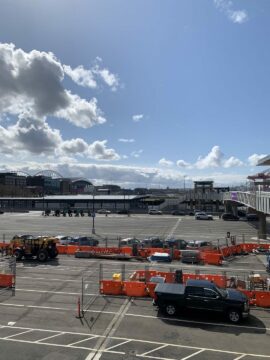Inland Waterways
Startup Uses Drone for Cleaning Water, Collecting Data
While the nation’s infrastructure earned a C- in the 2021 Infrastructure Report Card, Arkansas faces infrastructure challenges of its own. For example, driving on roads in need of repair in Arkansas costs each driver $671 per year, and 4.9% of bridges are rated structurally deficient. Drinking water needs in Arkansas are an estimated $7.4 billion. 193 dams are considered to be high-hazard potential. The state’s schools have an estimated capital expenditure gap of $350 million. This deteriorating infrastructure impedes Arkansas’s ability to compete in an increasingly global marketplace. Success in a 21st-century economy requires serious, sustained leadership on infrastructure investment at all levels of government. Delaying these investments only escalates the cost and risks of an aging infrastructure system, an option that the country, Arkansas, and families can no longer afford.

Aviation
$17.6 million in 2022 airport improvement grants across 6 major airports

Drinking Water
$7.7 billion total drinking water need

Transit
3.1 million passenger trips across 36 systems in 2021

Bridges
12,941 bridges, 5.2% of which were structurally deficient in 2021

Hazardous Waste
17 Superfund sites

Wastewater
$715 million total wastewater need

Dams
192 high hazard dams

Levees
1,593 miles of levees protect $53.1 billion of property.

Roads
58% of roads are in poor or fair condition
Smart investment will only be possible with strong leadership, decisive action, and a clear vision for our nation’s infrastructure.
If the United States is serious about achieving an infrastructure system fit for the future some specific steps must be taken, beginning with increased, long-term, consistent investment.
We must utilize new approaches, materials, and technologies to ensure our infrastructure can withstand or quickly recover from natural or man-made hazards.

ASCE: household, family savings from infrastructure investments
May 13, 2024
New ASCE economic study shows that American families and businesses save money if Congress, states, and the private sector continue recent investments....

Congress clears FAA reauthorization bill
May 02, 2024
After months of negotiations, Congress has passed legislation to reauthorize the Federal Aviation Administration (FAA). The House of Representatives passed the bill, the FAA Reauthorization...

April 03, 2024
On Wednesday, April 3rd, the replacement project for Seattle’s Multimodal Terminal at Colman Dock, one of the world’s busiest ferry terminals, was showcased by local...